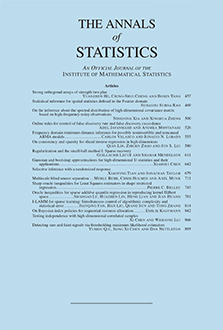Abstract
Vardi [Ann.Statist.13 178-203 (1985)] introduced an $s$-sample biased sampling model with known selection weight functions, gave a condition under which the common underlying probability distribution $G$ is uniquely estimable and developed simple procedure for computing the nonparametric maximum likelihood estimator (NPMLE) $\mathbb{G}_n$ of $G$. Gill, Vardi and Wellner thoroughly described the large sample properties of Vardi’s NPMLE, giving results on uniform consistency, convergence of $\sqrt{n}(\mathbb{G}-G)$ to a Gaussian process and asymptotic efficiency of $\mathbb{G}_n$. Gilbert, Lele and Vardi considered the class of semiparametric $s$-sample biased sampling models formed by allowing the weight functions to depend on an unknown finite-dimensional parameter $\theta$ .They extended Vardi’s estimation approach by developing a simple two-step estimation procedure in which $\hat{\theta}_n$ is obtained by maximizing a profile partial likelihood and $\mathbb{G}_n \equiv \mathbb{G}_n(\hat{\theta}_n)$ is obtained by evaluating Vardi’s NPMLE at $\hat{\theta}_n$. Here we examine the large sample behavior of the resulting joint MLE $(\hat{\theta}_n,\mathbb{G}_n)$, characterizing conditions on the selection weight functions and data in order that $(\hat{\theta}_n, \mathbb{G}_n)$ is uniformly consistent, asymptotically Gaussian and efficient.
Examples illustrated here include clinical trials (especially HIV vaccine efficacy trials), choice-based sampling in econometrics and case-control studies in biostatistics.
Citation
Peter B. Gilbert. "Large sample theory of maximum likelihood estimates in semiparametric biased sampling models." Ann. Statist. 28 (1) 151 - 194, February 2000. https://doi.org/10.1214/aos/1016120368
Information





